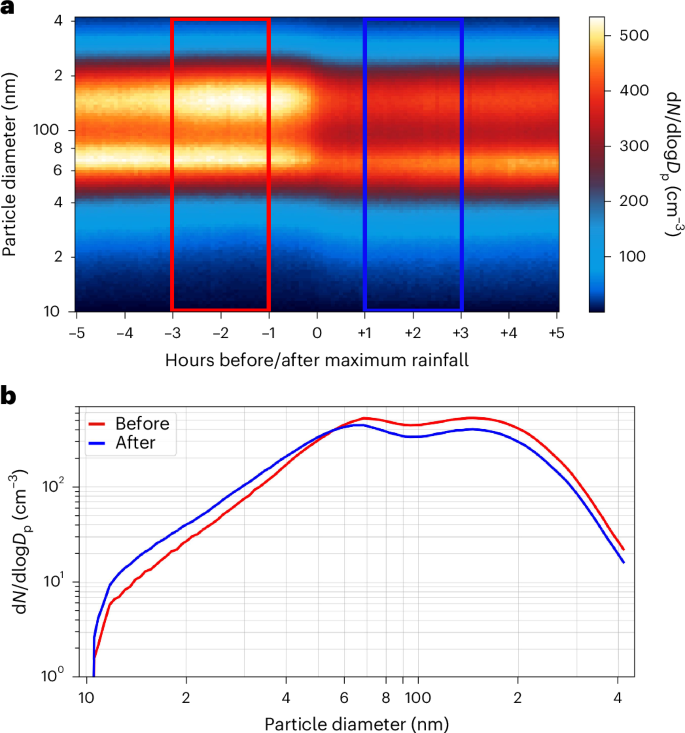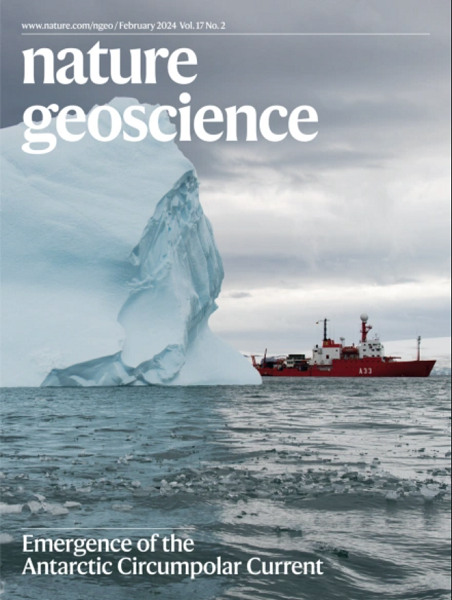亚马逊雨林树冠内频繁降雨导致的新颗粒形成
IF 16.1
1区 地球科学
Q1 GEOSCIENCES, MULTIDISCIPLINARY
引用次数: 0
摘要
大气气溶胶粒子对形成云层和降水至关重要,从而在区域和全球范围内影响地球的能量预算、水循环和气候。然而,人们对亚马逊雨林上空雨季气溶胶粒子的来源知之甚少。早期的研究表明,在深对流云的外流中会形成新的颗粒,并认为在降水事件中气溶胶颗粒会向下流动。在这里,我们利用亚马逊高塔观测站提供的综合气溶胶、痕量气体和气象数据表明,降雨会定期诱发成核粒径范围内的纳米粒子爆发。这可归因于与降雨有关的较大颗粒物的清除和冷凝汇的相应减少,以及向森林冠层注入臭氧,这可能会增加生物挥发性有机化合物(尤其是萜烯)的氧化,并促进新颗粒物的形成。在降雨期间和降雨之后,树冠正上方的成核粒子浓度要高于高处的成核粒子浓度。对于成核粒径范围而言,这种梯度在整个雨季都持续存在,表明冠层内颗粒物的形成是持续的,新形成的颗粒物是向上的净通量,亚马逊气溶胶-云-降水相互作用的理解范式发生了转变。粒子爆发为云凝结核的形成提供了一个合理的解释,从而导致当地形成绿色海洋云和降水。我们的研究结果表明,与降雨有关的凝结水汇减少、气体(主要是萜烯)和森林冠层颗粒物的一次排放以及对流云处理的相互作用,决定了原始雨林空气中云凝结核的数量。本文章由计算机程序翻译,如有差异,请以英文原文为准。


Frequent rainfall-induced new particle formation within the canopy in the Amazon rainforest
Atmospheric aerosol particles are essential for forming clouds and precipitation, thereby influencing Earth’s energy budget, water cycle and climate on regional and global scales. However, the origin of aerosol particles over the Amazon rainforest during the wet season is poorly understood. Earlier studies showed new particle formation in the outflow of deep convective clouds and suggested a downward flux of aerosol particles during precipitation events. Here we use comprehensive aerosol, trace gas and meteorological data from the Amazon Tall Tower Observatory to show that rainfall regularly induces bursts of nanoparticles in the nucleation size range. This can be attributed to rain-related scavenging of larger particles and a corresponding reduction of the condensation sink, along with an ozone injection into the forest canopy, which could increase the oxidation of biogenic volatile organic compounds, especially terpenes, and enhance new particle formation. During and after rainfall, the nucleation particle concentrations directly above the canopy are greater than those higher up. This gradient persists throughout the wet season for the nucleation size range, indicating continuous particle formation within the canopy, a net upward flux of newly formed particles and a paradigm shift in understanding aerosol–cloud–precipitation interactions in the Amazon. Particle bursts provide a plausible explanation for the formation of cloud condensation nuclei, leading to the local formation of green-ocean clouds and precipitation. Our findings suggest that an interplay of a rain-related reduction in the condensation sink, primary emissions of gases, mainly terpenes, and particles from the forest canopy, and convective cloud processing determines the population of cloud condensation nuclei in pristine rainforest air. Rainfall induces nanoparticle bursts within the Amazon rainforest canopy by scavenging large particles and bringing down ozone-rich air, according to aerosol, trace gas and meteorology data from the Amazon Tall Tower Observatory.
求助全文
通过发布文献求助,成功后即可免费获取论文全文。
去求助
来源期刊

Nature Geoscience
地学-地球科学综合
CiteScore
26.70
自引率
1.60%
发文量
187
审稿时长
3.3 months
期刊介绍:
Nature Geoscience is a monthly interdisciplinary journal that gathers top-tier research spanning Earth Sciences and related fields.
The journal covers all geoscience disciplines, including fieldwork, modeling, and theoretical studies.
Topics include atmospheric science, biogeochemistry, climate science, geobiology, geochemistry, geoinformatics, remote sensing, geology, geomagnetism, paleomagnetism, geomorphology, geophysics, glaciology, hydrology, limnology, mineralogy, oceanography, paleontology, paleoclimatology, paleoceanography, petrology, planetary science, seismology, space physics, tectonics, and volcanology.
Nature Geoscience upholds its commitment to publishing significant, high-quality Earth Sciences research through fair, rapid, and rigorous peer review, overseen by a team of full-time professional editors.
 求助内容:
求助内容: 应助结果提醒方式:
应助结果提醒方式:


